
Ceanothus is a genus of about 50–60 species of nitrogen-fixing shrubs and small trees in the buckthorn family (Rhamnaceae). Common names for members of this genus are buckbrush, California lilac, soap bush, or just ceanothus. "Ceanothus" comes from Ancient Greek: κεάνωθος (keanōthos), which was applied by Theophrastus to an Old World plant believed to be Cirsium arvense.

The Potamogetonaceae, commonly referred to as the pondweed family, is an aquatic family of monocotyledonous flowering plants. The roughly 110 known species are divided over six genera. The largest genus in the family by far is Potamogeton, which contains about 100 species.

The family Pandaceae consists of three genera that were formerly recognized in the Euphorbiaceae. Those are:

Chrysobalanaceae is a family of flowering plants, consisting of trees and shrubs in 27 genera and about 700 species of pantropical distribution with a centre of diversity in the Amazon. Some of the species contain silica in their bodies for rigidity and so the mesophyll often has sclerenchymatous idioblasts. The widespread species Chrysobalanus icaco produces a plum-like fruit and the plant is commonly known as the coco plum.
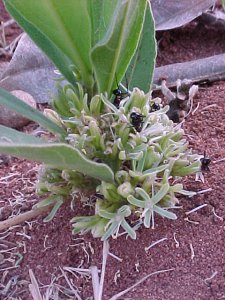
Dichapetalaceae is a family of flowering plants, consisting of 3 genera and about 170 species. Members of this family are trees, shrubs or lianas found in tropical and subtropical regions of the world.
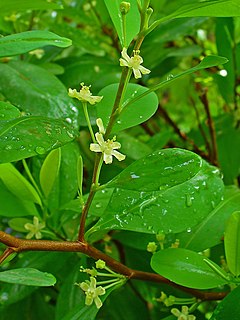
Erythroxylaceae is a family of flowering trees and shrubs consisting of 4 genera and 271 species. The four genera are AneulophusBenth., ErythroxylumP.Browne, NectaropetalumEngl., and PinacopodiumExell & Mendonça. The best-known species are the coca plants, including the species Erythroxylum coca, the source of the substance coca.

Ruppia, also known as the widgeonweeds, ditch grasses or widgeon grass, is the only extant genus in the family Ruppiaceae, with eight known species. These are aquatic plants widespread over much of the world. The genus name honours Heinrich Bernhard Rupp, a German botanist (1688-1719). They are widespread outside of frigid zones and the tropics.

Pittosporaceae is a family of flowering plants that consists of 200–240 species of trees, shrubs, and lianas in 9 genera. Habitats range from tropical to temperate climates of the Afrotropical, Indomalayan, Oceanian, and Australasian realms. The type genus is Pittosporum Banks ex Gaertn.

Aphanopetalum is a genus of twining shrubs or vines in the family Aphanopetalaceae which are endemic to Australia.
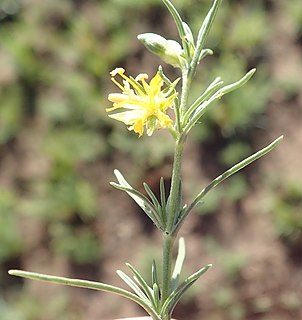
Vahlia is a genus of herbs and subshrubs that grow in Africa and the Indian subcontinent. There are at least five species.

Gerrardina is a genus of two species of trees, shrubs, and scrambling shrubs found in southeastern Africa. Until recently, the genus was placed in the polyphyletic family Flacourtiaceae, but it was abnormal there due to its apical placentation, small embryos, and mucilaginous foliar epidermis. Analyses of DNA data indicated that the genus did not fit in any known plant family and not clearly in any then-recognized order, and a new family, Gerrardinaceae, was thus created for it. Later analyses of additional DNA data and data from wood anatomy indicated that the family should be placed in the order Huerteales.

Sphenoclea is a genus of succulent erect annual herbs. They occur in damp habitats throughout the tropics.
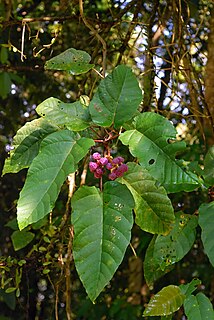
Poikilospermum is a genus of shrubs or tall woody climbers, consisting of at least 33 accepted species. The plants are found from India and China (Yunnan), the Sino-Himalayan region to Sulawesi and Jawa in Indonesia. Some of the plants are used by people.

Lopezia is a genus of plants of the family Onagraceae, largely restricted to Mexico and Central America.
William Albert Setchell was an American botanist and marine phycologist who taught at the University of California, Berkeley, where he headed the Botany Department. Among his publications are the Phycotheca Boreali-Americana, a multi-volume specimen collection of dried algae, and the Algae of Northwestern America, a reference work.

Crossopetalum, commonly known as Christmas-berries or maiden berries, is a genus of flowering plants in the family Celastraceae. It comprises about 30-40 species.
Jagrantia is a monotypic genus of flowering plants belonging to the family Bromeliaceae. It only contains one species, Jagrantia monstrum(Mez) Barfuss & W.Till
Neomortonia is a monotypic genus of flowering plants belonging to the family Gesneriaceae. It just contains one species, Neomortonia roseaWiehler
Landiopsis is a monotypic genus of flowering plants belonging to the family Rubiaceae. It only contains one known species, Landiopsis capuroniiBosser
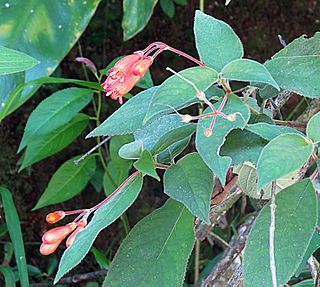
Moussonia is a genus of plants in the family Gesneriaceae. Its native range stretches from Mexico to Central America. It is found in Costa Rica, El Salvador, Guatemala, Honduras, Mexico and Panamá.















